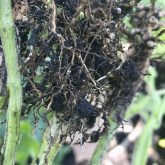There’s no denying it. Corn has outperformed soybeans for the last two years, both in the field and at the elevator. But at a time when many growers are questioning the overall value of soybeans, and when they’re voting with their planters in favour of corn, there are rumblings that maybe we’re throwing out the IP baby with the bathwater — and that we may come to regret it sooner rather than later.
Sure, corn on corn is getting easier to pull off. However, there is a contingent — growers, agronomists, seed dealers and buyers — that are worried Canada is sacrificing our stellar international reputation for the sake of a corn market that can’t last.
Read Also

Producers aren’t panicking over tariffs and trade threats
The influence of tariff and trade uncertainity on farm business decisions.
Maybe these IP enthusiasts are smaller in number than the corn crowd, but does that make them wrong?
According to multiple sources, the identity-preserved (IP) market for Ontario growers once sat as high as 35 per cent of overall soybean production. Today, that share is roughly 25 per cent.
The market has dropped, but still it’s a viable one out of every four acres.
For years, agricultural economists and brokers have rationalized the IP sector by noting that a 50-cent or a dollar-per-bushel premium means more on a percentage basis at $5 per bushel than it does at $10.
So, now that soybean prices are in the low teens, and now that non-IP soybeans are even easier to grow thanks to the convenience of herbicide-tolerant technologies and the launch of newer, higher-yielding varieties, the question becomes, “Will the added cost and management of IP pay for itself?”
After all, IP brings more work with weed control plus elevator discounts for mud tagging (as in the 2011 crop), not to mention the potential for dockage and even rejection by the buyer and elevators.
Late in 2011, Pat Lynch acknowledged the difficulty of deciding between Roundup Ready soybean varieties and IP soybeans. Yet when he compares the ease and convenience of the former versus the premiums with the latter, he concludes that it is best for growers to include some IP soybeans in their mix.
Lynch is adamant. Growers must continue to service the market, for he fears that Canada’s reputation as a supplier of high-quality food-grade beans is at stake.
“If the Ontario growers abandon it or seriously reduce the acres, it’s not something we can just turn off and turn on again,” cautions Lynch, now an independent certified crop adviser. He concedes that it is much easier to grow GMO soybean varieties and that at current pricing levels, it is easy to see a fairly good return coming out of the field. “However, we have to be thinking long term. We will have harder times back in the crop world. Then we will need the extra revenue from IP soybeans. Ontario has a name for high-quality IP soybeans, and we have to work at it.”
The bloom off the rose
Lynch is far from alone. Despite the ease and convenience of the latest GM soybean varieties, John Cowan agrees that there is too much at stake to give up on IP soys. Yet Cowan understands why market conditions dictate more of what growers will do than any sense of tradition.
“The market always tells the farmer which direction to go and which direction not to go,” says Cowan, the vice-president of strategic development for the Grain Farmers of Ontario. “The market is telling farmers to produce more corn and also the price of soybeans is saying that the extra effort and energy required to produce IP soybeans is not what I need right now.”
Having said that, Cowan is quick to point out that there are other factors that have the potential to drive growers back to IP markets. From his vantage point, he sees a day when researchers and breeders will begin to differentiate the soybean market, even within the IP sector.
“Food health is an obvious way to go. So is exploring some of our domestic markets, and we haven’t even started to tap into the opportunity with what I would call ‘new tastes’ or the taste buds of new Canadians,” Cowan says.
The other factor which may become more pressing, both in terms of frequency and intensity, is herbicide resistance, particularly with glyphosate-tolerant hybrids and varieties. The seed and chemical sectors seem to be focused more on developing seeds with the traits that are in demand, while Cowan believes there isn’t the same investment into superior end-use value.
Still, the crux of the issue for the short term is staying the course and maintaining IP acres, and Cowan assures growers and buyers that every effort will be made, particularly from the Grain Farmers of Ontario perspective, to maintain and grow the market for IP soybeans.
“We’re going to work hard to make sure that we continue to be knowledgeable and good stewards and growers,” says Cowan, adding that traceability and accountability will continue to be hallmarks for Ontario growers. “Every time we can segregate a market, we add value to that market.”
Broaden the view
For Martin Harry, the issue goes far beyond Ontario’s borders. Like Cowan and Lynch, Harry acknowledges the reputation that Ontario IP growers have earned, but he wonders whether there is the understanding among growers of just how far that reputation reaches.
Harry differs on another point too. He thinks growers will stick with IP because they have a passion for it, not just because the economics are a penny one way or the other.
“Farmers aren’t going to change, and I don’t want to take the negative point of view, but we’re under pressure, the bookings are slow to come,” says Harry, eastern marketing manager for SeCan. “But on the positive side, there are a lot of open and unbooked acres of beans through the southwest and through the north. Some are telling me that the corn sales were extremely good for bookings but bean sales have been slower and thus there are open acres.”
Whether those acres will go to corn in the spring, or go to IP soybeans or glyphosate-tolerant varieties remains to be seen, and there may be a lot of uncertainty right until the seed is in the ground.
For his part, Harry is quick to suggest that many American suppliers are becoming more short sighted. The fact our neighbours in the U.S. Midwest are so heavily focused on GM soybeans takes their eyes off Ontario’s place in a global market, which gives us less competition not only in Japan and the Pacific Rim countries, but also in Europe.
“There is no other place in the world, in my mind, that is doing as much work on conventional soybeans and coming out with new varieties,” explains Harry, talking of the work being done by Canada’s public-sector breeders and researchers. “Why do I get demand from all of the European countries, looking for conventional soybeans?”
Of course, he adds, there’s a danger inherent in our status as a well-known food-grade soybean supplier.
More European buyers are starting to ask about us now. But if we have to tell them that we won’t have supply next fall, how long will they keep asking?
Still, Harry believes that Ontario’s leadership comes from honest roots. We have a long-standing focus on the conventional sector, along with the temperate climate that helps produce high-quality beans. “Conventional soybeans aren’t new, they’ve been here forever, and they’re the breadbasket for me and my growers,” Harry says.
“But even in my system, it’s, ‘What’s new?’”
The hard numbers
If there is any doubt as to the importance of markets for IP food-grade soybeans, Jim Gowland can help find the right perspective. Gowland not only has a long history as an IP grower, he is the founder and former chair of the Canadian Soybean Council.
Gowland takes Harry’s reference to the European market and puts some numbers to it to emphasize its value.
“The EU market has grown to nearly 1.2 million tonnes in 2010,” says Gowland, who farms near Holyrood in southern Bruce County. “That has been a very substantial increase in tonnage to the EU in recent years.”
On the other side of the world, Japan represents a single market in Asia that is approaching 400,000 tonnes.
“And that’s a premium, premium market, there’s no doubt about that,” says Gowland. For that market, adds Gowland, “at this point in time, we’re probably looking at an average of at least $2-per-bushel grower premium at the farm gate — mainly for non-GM white hilum soybeans for tofu, miso and soy beverage production.”
From a perspective of total global market value, the combination of premium-based soybean markets could pump a minimum of $50 million annually into Canadian growers’ pockets. It’s a strong argument for continuing to build and maintain the Canadian brand, says Gowland, adding to Harry’s comment regarding Canada’s dominance of the IP soybean market, particularly measured against U.S. efforts to increase their market share.
“The U.S has been a little more involved in IP soybean production during the last number of years, and is very competitive in the same markets that Canada is involved with,” Gowland says. “However, the Japan food-grade market represents a million tonnes and is a fairly mature market, so you’re not going to see too much more growth. But it’s a situation where Canada has grown the Japanese market share to nearly 400,000 tonnes in recent years, and that’s a pretty major achievement.”
One thing also worth keeping in mind, in terms of measuring the IP market on a Canadian level is Gowland’s observation regarding total soybean production in the past 10 years. It was not long ago that Canada, as a country, was producing less than three million tonnes of soybeans, annually. In 2010, that number was nearly 4.4 million tonnes and much of that growth in the past five to seven years has come from Manitoba, with some also grown in Quebec, Prince Edward Island and Saskatchewan.
“Certainly the new growth has not been here in Ontario,” Gowland says.
At the same time, exports have also boomed, climbing to 2.2 million tonnes in 2010 from 1.7 million tonnes only a few years ago.
IP has kept pace, Gowland says. “This equates to 60 per cent of Canadian soybeans being exported.”
In fact, it may turn out that IP acres in Ontario don’t fall as much as they climb in other provinces. Nevertheless, these market-watchers say, attention must be paid to maintaining, if not continuing to build, Canada’s IP market. CG















